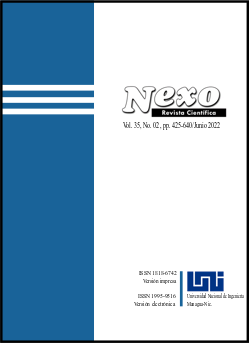Multifunctional multilevel moisture sensor
DOI:
https://doi.org/10.5377/nexo.v35i02.14638Keywords:
Device sensor, Analyzer, Gateway, Functional module, Humidity, Digital irrigation map, Non-volatility, Intelligent control, Radio communication, Geo-positioningAbstract
Controlling the moisture level is especially important when irrigating various crops to obtain a resistant, stable harvest and save water resources. Over moistening of the soil adversely affects the soil structure and can lead to salinization, waterlogging, and acidification. In addition, the formation of surface water runoff from the fields causes depletion of nutrients, oxygen starvation, and, ultimately, soil degradation. The degradation of fields (areas of the field) leads to the withdrawal of the field from crop rotation (exploitation), a reduction in acreage, the need for agrotechnical measures, reclamation, and, as a result, high financial costs. Currently applied irrigation technologies lead to the withdrawal of up to 50% of irrigated land. Therefore, the technology of differentiated irrigation with constant control over the condition of the soil and plants will help eliminate these negative consequences while increasing the yield and reducing the consumption of water, electricity, and labor costs. For the implementation of this technology, sensors are needed to control the moisture and temperature of the soil at different depths and perform operational control of the water supply to the field. The implementation of a constant connection between the field and the plant with the water supply system will allow creating digital irrigation map and forming of a database about the irrigated field underlying the information and created advisory system. The system for the continuous monitoring of soil moisture and temperature at different depths is based on IT technology with data transmission via radio communication channels. It uses platforms for data transmission via such communication channels as LoRaWAN (highly economical wireless communication interface from ICBCom), GSM (Groupe Spécial Mobile - the global standard for digital mobile cellular communication), and the Internet.
Downloads
1557
Downloads
Published
How to Cite
Issue
Section
License
Copyright (c) 2022 Universidad Nacional de Ingeniería

This work is licensed under a Creative Commons Attribution 4.0 International License.
The authors who publish in Nexo Scientific Journal agree to the following terms:
- Authors retain the copyright and grant the journal the right of the first publication under the license Creative Commons Attribution License, which allows others to share the work with a recognition of the authorship of the work and the initial publication in Nexo Scientific Journal.
- Authors may separately establish additional agreements for the non-exclusive distribution of the version of the work published in the journal (for example, in an institutional repository or a book), with the recognition of the initial publication in Nexo Scientific Journal.
- Authors are allowed and encouraged to disseminate their works electronically (for example, in institutional repositories or in their own website) before and during the submission process, as it can lead to productive exchanges, as well as earlier and greater citation of published works.










